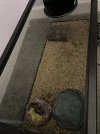Nugget8581
New Member
Hi,
A friend was giving away a tortoise, so we took it home yesterday. It was perky during the day and then stopped moving last night. Today it barely moved but would pulse it's head and front legs occasionally. The back legs are out. It hasn't eaten or had any water.
We don't know what to do with it and are afraid it's dying. It was under its uv light all day but seems so weak. Any suggestions would be appreciated.
Thanks.
A friend was giving away a tortoise, so we took it home yesterday. It was perky during the day and then stopped moving last night. Today it barely moved but would pulse it's head and front legs occasionally. The back legs are out. It hasn't eaten or had any water.
We don't know what to do with it and are afraid it's dying. It was under its uv light all day but seems so weak. Any suggestions would be appreciated.
Thanks.


